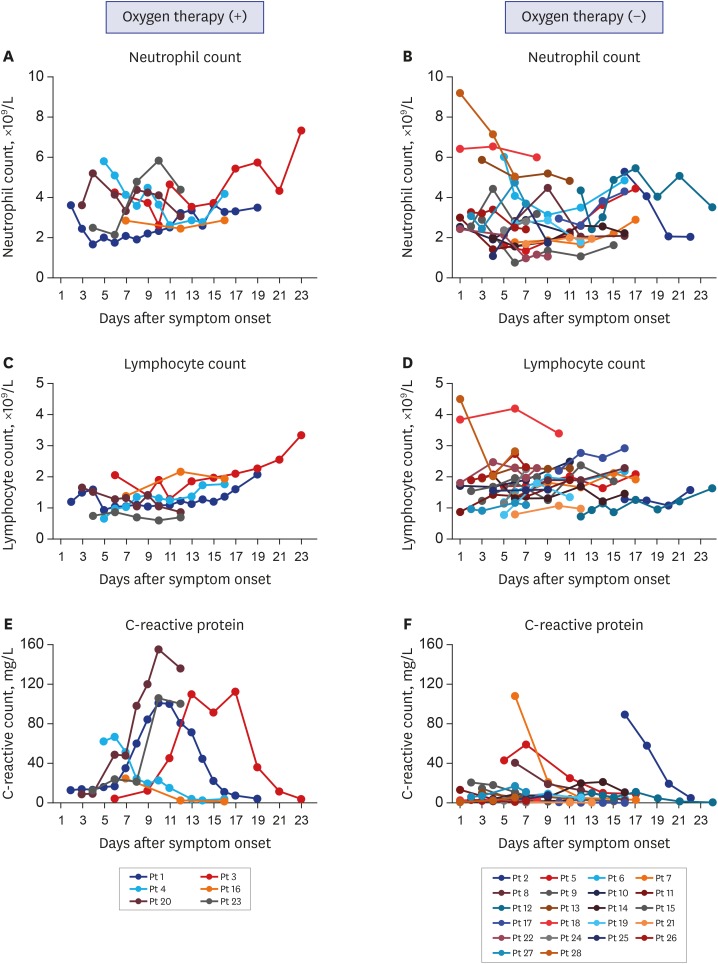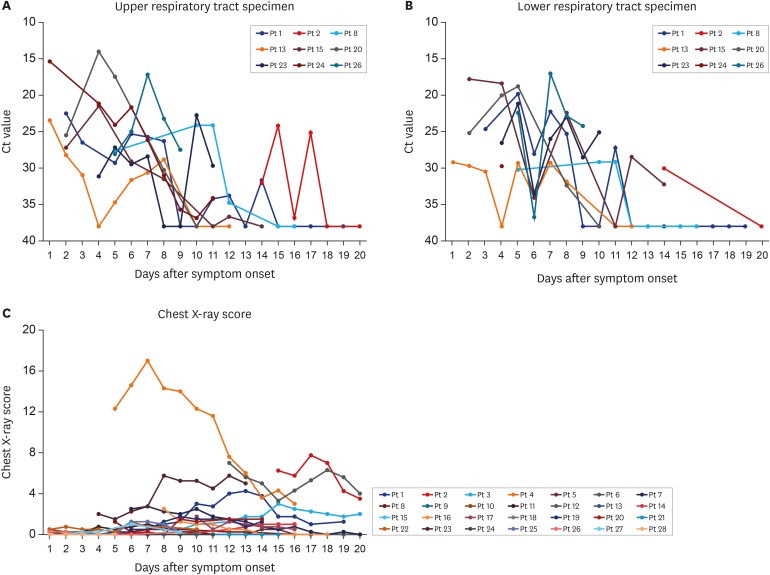Clinical Course and Outcomes of Patients with Severe Acute Respiratory Syndrome Coronavirus 2 Infection: a Preliminary Report of the First 28 Patients from the Korean Cohort Study on COVID-19
- Affiliations
-
- 1Department of Internal Medicine, Seoul National University Bundang Hospital, Seoul National University College of Medicine, Seongnam, Korea.
- 2Division of Infectious Diseases, Department of Internal Medicine, National Medical Center, Seoul, Korea.
- 3Department of Internal Medicine, Seoul National University College of Medicine, Seoul, Korea.
- 4Department of Infectious Diseases, Myongji Hospital, Goyang, Korea.
- 5Department of Internal Medicine, Seoul Medical Center, Seoul, Korea.
- 6Division of Infectious Diseases, Department of Internal Medicine, Armed Forces Capital Hospital, Seongnam, Korea.
- 7Department of Internal Medicine, Gyeonggi Provincial Medical Center Ansung Hospital, Anseong, Korea.
- 8Department of Infectious Diseases, Chonnam National University Medical School, Gwangju, Korea.
- 9Department of Internal Medicine, College of Medicine, Chosun University, Gwangju, Korea.
- 10Department of Internal Medicine, Wonkwang University School of Medicine, Iksan, Korea.
- 11Division of Infectious Diseases, Department of Internal Medicine, Incheon Medical Center, Incheon, Korea.
- 12Division of Infectious Diseases, Seoul Metropolitan Government-Seoul National University Boramae Medical Center, Seoul, Korea.
- 13Department of Pediatrics, National Medical Center, Seoul, Korea.
- KMID: 2509606
- DOI: http://doi.org/10.3346/jkms.2020.35.e142
Abstract
- Background
Severe acute respiratory syndrome coronavirus 2 (SARS-CoV-2)-infected pneumonia emerged in Wuhan, China in December 2019. In this retrospective multicenter study, we investigated the clinical course and outcomes of novel coronavirus disease 2019 (COVID-19) from early cases in Republic of Korea.
Methods
All of the cases confirmed by real time polymerase chain reaction were enrolled from the 1st to the 28th patient nationwide. Clinical data were collected and analyzed for changes in clinical severity including laboratory, radiological, and virologic dynamics during the progression of illness.
Results
The median age was 40 years (range, 20–73 years) and 15 (53.6%) patients were male. The most common symptoms were cough (28.6%) and sore throat (28.6%), followed by fever (25.0%). Diarrhea was not common (10.7%). Two patients had no symptoms. Initial chest X-ray (CXR) showed infiltration in 46.4% of the patients, but computed tomography scan confirmed pneumonia in 88.9% (16/18) of the patients. Six patients (21.4%) required supplemental oxygen therapy, but no one needed mechanical ventilation. Lymphopenia was more common in severe cases. Higher level of C-reactive protein and worsening of chest radiographic score was observed during the 5–7 day period after symptom onset. Viral shedding was high from day 1 of illness, especially from the upper respiratory tract (URT).
Conclusion
The prodromal symptoms of COVID-19 were mild and most patients did not have limitations of daily activity. Viral shedding from URT was high from the prodromal phase. Radiological pneumonia was common from the early days of illness, but it was frequently not evident in simple CXR. These findings could be plausible explanations for the easy and rapid spread of SARS-CoV-2 in the community.
Keyword
Figure
Cited by 12 articles
-
Encountering COVID-19 as Endocrinologists
Eun-Jung Rhee, Jung Hee Kim, Sun Joon Moon, Won-Young Lee
Endocrinol Metab. 2020;35(2):197-205. doi: 10.3803/EnM.2020.35.2.197.Prevalence and Duration of Acute Loss of Smell or Taste in COVID-19 Patients
Yonghyun Lee, Pokkee Min, Seonggu Lee, Shin-Woo Kim
J Korean Med Sci. 2020;35(18):e174. doi: 10.3346/jkms.2020.35.e174.Clinical Course and Outcomes of 3,060 Patients with Coronavirus Disease 2019 in Korea, January–May 2020
Ho Kyung Sung, Jin Yong Kim, Jeonghun Heo, Haesook Seo, Young soo Jang, Hyewon Kim, Bo Ram Koh, Neungsun Jo, Hong Sang Oh, Young Mi Baek, Kyung-Hwa Park, Jeung A Shon, Min-Chul Kim, Joon Ho Kim, Hyun-Ha Chang, Yukyung Park, Yu Min Kang, Dong Hyun Lee, Dong Hyun Oh, Hyun Jung Park, Kyoung-Ho Song, Eun Kyoung Lee, Hyeongseok Jeong, Ji Yeon Lee, Ja-Young Ko, Jihee Choi, Eun Hwa Ryu, Ki-hyun Chung, Myoung-don Oh,
J Korean Med Sci. 2020;35(30):e280. doi: 10.3346/jkms.2020.35.e280.Viral Load Kinetics of SARS-CoV-2 Infection in Saliva in Korean Patients: a Prospective Multi-center Comparative Study
Seong Eun Kim, Ji Yeon Lee, Ahrang Lee, Soosung Kim, Kyung-Hwa Park, Sook-In Jung, Seung-Ji Kang, Tae Hoon Oh, Uh Jin Kim, Seung Yeob Lee, Seung-Jung Kee, Hee-Chang Jang
J Korean Med Sci. 2020;35(31):e287. doi: 10.3346/jkms.2020.35.e287.Characteristics of Acute Stroke in Patients with Coronavirus Disease 2019 and Challenges in Stroke Management during an Epidemic
Doo Hyuk Kwon, Youngrok Do, Mi-Yeon Eun, Jun Lee, Hyungjong Park, Sung-Il Sohn, Jeong-Ho Hong
J Korean Med Sci. 2020;35(35):e324. doi: 10.3346/jkms.2020.35.e324.Clinical Characteristics and Mortality Predictors of COVID-19 Patients Hospitalized at Nationally-Designated Treatment Hospitals
Seong-Su Moon, Kwan Lee, Jungi Park, Seongcheol Yun, Yun Sik Lee, Dong Seok Lee
J Korean Med Sci. 2020;35(36):e328. doi: 10.3346/jkms.2020.35.e328.Real Asymptomatic SARS-CoV-2 Infection Might Be Rare: Importance of Careful Interviews and Follow-up
Tae Heum Jeong, Chuiyong Pak, Minsu Ock, Seock-Hwan Lee, Joung Sik Son, Young-Jee Jeon
J Korean Med Sci. 2020;35(37):e333. doi: 10.3346/jkms.2020.35.e333.COVID-19 Patients Upregulate Toll-like Receptor 4-mediated Inflammatory Signaling That Mimics Bacterial Sepsis
Kyung Mok Sohn, Sung-Gwon Lee, Hyeon Ji Kim, Shinhyea Cheon, Hyeongseok Jeong, Jooyeon Lee, In Soo Kim, Prashanta Silwal, Young Jae Kim, Seungwha Paik, Chaeuk Chung, Chungoo Park, Yeon-Sook Kim, Eun-Kyeong Jo
J Korean Med Sci. 2020;35(38):e343. doi: 10.3346/jkms.2020.35.e343.Clinical Features of COVID-19 in Uzbekistan
KyungHee Kim, Jae Wook Choi, Juyoung Moon, Habibulla Akilov, Laziz Tuychiev, Bakhodir Rakhimov, Kwang Sung Min
J Korean Med Sci. 2020;35(45):e404. doi: 10.3346/jkms.2020.35.e404.Clinical Characteristics and Outcomes of COVID-19 Cohort Patients in Daegu Metropolitan City Outbreak in 2020
Shin-Woo Kim, Seung-Mee Kim, Yu Kyung Kim, Jong-yeon Kim, Yu-Mi Lee, Bong-Ok Kim, Suhyun Hwangbo, Taesung Park
J Korean Med Sci. 2020;36(1):e12. doi: 10.3346/jkms.2021.36.e12.Analysis of PubMed and KoreaMed Indexed Korean Publications on COVID-19
Jong-Min Kim, Jin-Hong Yoo, Hae Kyung Cho, Sung-Tae Hong
J Korean Med Sci. 2021;36(49):e345. doi: 10.3346/jkms.2021.36.e345.Risk Factors for the Prescription of Ineffective Antiviral Candidates for COVID-19 During the Early Pandemic Period in Korea
Eunyoung Lee, Seungyeon Kim, Sun Young Lee, Joo Jeong, Jihwan Bang, Juhwan Oh, Sang Do Shin, Nam Joong Kim, Pyoeng Gyun Choe, Myoung-don Oh
J Korean Med Sci. 2023;38(36):e280. doi: 10.3346/jkms.2023.38.e280.
Reference
-
1. Zhu N, Zhang D, Wang W, Li X, Yang B, Song J, et al. A novel coronavirus from patients with pneumonia in China, 2019. N Engl J Med. 2020; 382(8):727–733. PMID: 31978945.
Article2. World Health Organization main website. Updated 2020. Accessed March 31, 2020. https://www.who.int.3. Choi WS, Kang CI, Kim Y, Choi JP, Joh JS, Shin HS, et al. Clinical presentation and outcomes of Middle East respiratory syndrome in the Republic of Korea. Infect Chemother. 2016; 48(2):118–126. PMID: 27433382.4. Kim JY, Choe PG, Oh Y, Oh KJ, Kim J, Park SJ, et al. The first case of 2019 novel coronavirus pneumonia imported into Korea from Wuhan, China: implication for infection prevention and control measures. J Korean Med Sci. 2020; 35(5):e61. PMID: 32030925.
Article5. Kim JY, Ko JH, Kim Y, Kim YJ, Kim JM, Chung YS, et al. Viral load kinetics of SARS-CoV-2 infection in first two patients in Korea. J Korean Med Sci. 2020; 35(7):e86. PMID: 32080991.
Article6. Lim J, Jeon S, Shin HY, Kim MJ, Seong YM, Lee WJ, et al. Case of the index patient who caused tertiary transmission of COVID-19 infection in Korea: the application of lopinavir/ritonavir for the treatment of COVID-19 infected pneumonia monitored by quantitative RT-PCR. J Korean Med Sci. 2020; 35(6):e79. PMID: 32056407.
Article7. The Korea Centers for Disease Control and Prevention. Updated 2020. Accessed February 14, 2020. http://ncov.mohw.go.kr/index_main.jsp.8. Korean Society of Infectious Diseases. Korean Society of Pediatric Infectious Diseases. Korean Society of Epidemiology. Korean Society for Antimicrobial Therapy. Korean Society for Healthcare-associated Infection Control and Prevention; Korea Centers for Disease Control and Prevention. Report on the epidemiological features of coronavirus disease 2019 (COVID-19) outbreak in the Republic of Korea from January 19 to March 2, 2020. J Korean Med Sci. 2020; 35(10):e112. PMID: 32174069.9. Huang C, Wang Y, Li X, Ren L, Zhao J, Hu Y, et al. Clinical features of patients infected with 2019 novel coronavirus in Wuhan, China. Lancet. 2020; 395(10223):497–506. PMID: 31986264.
Article10. Chan JF, Yuan S, Kok KH, To KK, Chu H, Yang J, et al. A familial cluster of pneumonia associated with the 2019 novel coronavirus indicating person-to-person transmission: a study of a family cluster. Lancet. 2020; 395(10223):514–523. PMID: 31986261.
Article11. Chen N, Zhou M, Dong X, Qu J, Gong F, Han Y, et al. Epidemiological and clinical characteristics of 99 cases of 2019 novel coronavirus pneumonia in Wuhan, China: a descriptive study. Lancet. 2020; 395(10223):507–513. PMID: 32007143.
Article12. Wang D, Hu B, Hu C, Zhu F, Liu X, Zhang J, et al. Clinical characteristics of 138 hospitalized patients with 2019 novel coronavirus-infected pneumonia in Wuhan, China. JAMA. 2020.
Article13. Chang , Lin M, Wei L, Xie L, Zhu G, Dela Cruz CS, et al. Epidemiologic and clinical characteristics of novel coronavirus infections involving 13 patients outside Wuhan, China. JAMA. 2020.
Article14. Li Q, Guan X, Wu P, Wang X, Zhou L, Tong Y, et al. Early transmission dynamics in Wuhan, China, of novel coronavirus-infected pneumonia. N Engl J Med. 2020; 382(13):1199–1207. PMID: 31995857.15. COVID-19 National Emergency Response Center, Epidemiology and Case Management Team, Korea Centers for Disease Control and Prevention. Early epidemiological and clinical characteristics of 28 cases of coronavirus disease in South Korea. Osong Public Health Res Perspect. 2020; 11(1):8–14. PMID: 32149037.16. World Health Organization. Global COVID-19 Clinical Characterization Case Record Form. Geneva: World Health Organization;2020.17. Kim JM, Chung YS, Jo HJ, Lee NJ, Kim MS, Woo SH, et al. Identification of coronavirus isolated from a patient in Korea with COVID-19. Osong Public Health Res Perspect. 2020; ;; 11:(; (1):):; 3-; –7. PMID: 32149036.
Article18. Oh MD, Park WB, Choe PG, Choi SJ, Kim JI, Chae J, et al. Viral load kinetics of MERS coronavirus infection. N Engl J Med. 2016; 375(13):1303–1305.
Article19. Fung TS, Liu DX. Human coronavirus: host-pathogen interaction. Annu Rev Microbiol. 2019; 73(1):529–557. PMID: 31226023.
Article20. Zhou P, Yang XL, Wang XG, Hu B, Zhang L, Zhang W, et al. A pneumonia outbreak associated with a new coronavirus of probable bat origin. Nature. 2020; 579(7798):270–273. PMID: 32015507.21. Lu R, Zhao X, Li J, Niu P, Yang B, Wu H, et al. Genomic characterisation and epidemiology of 2019 novel coronavirus: implications for virus origins and receptor binding. Lancet. 2020; 395(10224):565–574. PMID: 32007145.22. Zhang Y, Chen C, Zhu S, Shu C, Wang D, Song J, et al. Isolation of 2019-nCoV from a stool specimen of a laboratory-confirmed case of the coronavirus disease 2019 (COVID-19). China CDC Wkly. 2020; 8:123–124.
Article23. Yeo C, Kaushal S, Yeo D. Enteric involvement of coronaviruses: is faecal-oral transmission of SARS-CoV-2 possible? Lancet Gastroenterol Hepatol. 2020; 5(4):335–337. PMID: 32087098.
Article24. Zou L, Ruan F, Huang M, Liang L, Huang H, Hong Z, et al. SARS-CoV-2 viral load in upper respiratory specimens of infected patients. N Engl J Med. 2020; 382(12):1177–1179. PMID: 32074444.
Article25. Peiris JS, Chu CM, Cheng VC, Chan KS, Hung IF, Poon LL, et al. Clinical progression and viral load in a community outbreak of coronavirus-associated SARS pneumonia: a prospective study. Lancet. 2003; 361(9371):1767–1772. PMID: 12781535.
Article26. Cowling BJ, Leung GM. Epidemiological research priorities for public health control of the ongoing global novel coronavirus (2019-nCoV) outbreak. Euro Surveill. 2020; 25(6):2000110.
Article
- Full Text Links
- Actions
-
Cited
- CITED
-
- Close
- Share
- Similar articles
-
- Severe asthma exacerbation associated with COVID-19 in children: A case report
- Epidemiology, Virology, and Clinical Features of Severe Acute Respiratory Syndrome Coronavirus 2 (SARS-CoV-2; Coronavirus Disease-19)
- Understanding the impact on digestive disease in the post-COVID-19 condition: Editorial on “Long-term gastrointestinal and hepatobiliary outcomes of COVID-19: A multinational population-based cohort study from South Korea, Japan, and the UK”
- Management of patients with allergic diseases in the era of COVID-19
- Epidemiology, virology, and clinical features of severe acute respiratory syndrome -coronavirus-2 (SARS-CoV-2; Coronavirus Disease-19)



